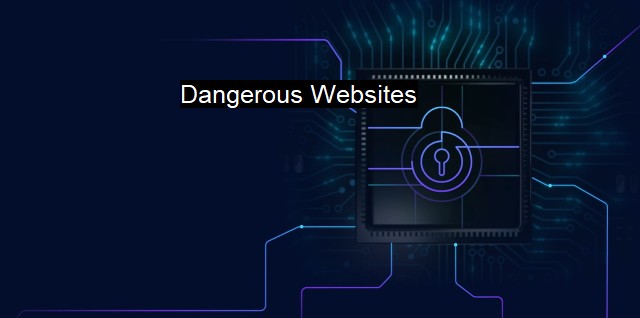What are Dangerous Websites?
Defending Against Cybercrime: Navigating the Risks and Dangers of Dangerous Websites
"Dangerous websites" are web platforms that pose a potential risk to a user's online security and privacy. They exist in different forms, with some designed to install malicious software, also known as malware, on your device without your knowledge. Others try to trick you into supplying personal information like credit card details or passwords. In the realm of cybersecurity and antivirus technology, it's crucial to understand the nature of these websites, recognize potential threats and learn how to secure your online activity from cybercriminals.a dangerous website can include any web platform that can harm your computer or steal Private Personally Identifiable Information (PII). Such sites often host malware, such as viruses, worms, ransomware, spyware, adware, and Trojan horses, hazardous types of software that can infect your device, disrupt its operation, collect sensitive information or even gain control over your system.
Dangerous websites may also be involved in phishing, a deceptive practice where attackers pose as reputable entities and trick users into revealing personal information like login credentials, credit card numbers, or social security numbers. Such sites often rely on wildly compelling lures, like emergency alerts or enticing offers, to manipulate the psychological behavior of visitors into performing risky online actions.
Another category of potentially harmful websites are those packed with excessive advertisements and pop-ups. These sites exploit clickbait tactics, often leading users to unintentionally click on misleading links, resulting in accidental downloads of malware or driving traffic to other dangerous websites.
Dangerous websites can also make use of 'drive-by' downloads. These occur when a website installation or script runs in the background while the user is browsing the site, often unbeknownst to the user. Despite their minimal interaction with the site, users find themselves victims of malware installation which exposes their systems to major security risks.
In some particularly invasive instances, dangerous websites may even employ cryptojacking techniques. Cryptojackers utilize system resources from visitor's devices to mine cryptocurrencies. While this might not directly translate to stolen data, it can seriously impede device performance and potentially lead to hardware degradation.
The significance of cybersecurity and robust antivirus solutions cannot be overstated in combating dangerous websites. Antivirus software often utilizes virus definitions or signatures to recognize threats, and regularly update to keep up with evolving malware. Whilst firewalls provide a defensive barricade between the internet and your computer, antivirus programs can detect, quarantine, and eliminate any potential threats that make it through. most modern browsers provide protection layers that warn users when they attempt to visit potentially dangerous websites.
Also integral is cybersecurity education to enhance awareness. Understanding the signs of dangerous websites can save users from potential harm. For instance, looking for 'http' in the address instead of 'https', where 's' stands for secure, can indicate potential vulnerabilities. Poor website design, excessive pop-up ads, along with unexpected redirects, can serve as telltale signs of dangerous websites.
'dangerous websites' refers to any online platform that poses risks to users' digital privacy and security, from distributing malware, orchestrating phishing attacks, operating deceptive advertising, executing 'drive-by' downloads, to conducting cryptojacking. To counteract these threats, robust cyber hygiene practices in conjunction with effective use of cybersecurity and antivirus solutions are essential. As cybersecurity threats continue to evolve, individual vigilance and preventive countermeasures remain the first line of defense against these potential threats lurking in cyberspace. Regular software and system updates, encryption of personal data, mindful online behavior, and sharing user experiences can fortify online experience, building up digital resilience against dangerous websites.

Dangerous Websites FAQs
What are dangerous websites and how can they harm my system?
Dangerous websites are websites that contain malicious content such as viruses, malware, phishing scams, and other harmful content. These websites can harm your system by stealing your personal information, damaging your files, and compromising your security.How can I identify a dangerous website?
You can identify a dangerous website by looking for signs such as suspicious URL links, poor website design, pop-up ads, and warning messages from your antivirus software. It is important to avoid clicking on suspicious links or downloading files from unknown sources.What should I do if I accidentally visit a dangerous website?
If you accidentally visit a dangerous website, immediately close the webpage and run a full virus scan on your system. If you entered any personal information on the website, then immediately change your passwords and contact your bank or credit card company to secure your accounts.How can I protect my system from dangerous websites?
To protect your system from dangerous websites, use a reputable antivirus software that has web protection features. Keep your software updated with the latest security patches and avoid clicking on suspicious links or downloading files from untrusted sources. Practice safe browsing habits and use strong passwords to secure your online accounts.| | A | | | B | | | C | | | D | | | E | | | F | | | G | | | H | | | I | | | J | | | K | | | L | | | M | |
| | N | | | O | | | P | | | Q | | | R | | | S | | | T | | | U | | | V | | | W | | | X | | | Y | | | Z | |
| | 1 | | | 2 | | | 3 | | | 4 | | | 7 | | | 8 | | |||||||